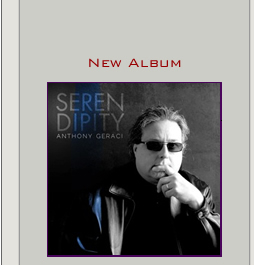 Anthony Geraci has just released his second solo jazz CD Serendipity, and the disc is loaded with cool jazz piano and strikingly interesting original compositions. The keyboard man from Sugar Ray And The Blue Tones has a blast tinkling his fanciful melodies and icy cool chords amidst a who’s who of some of greater-Boston’s finest talent. Like all good jazz, these compositions have a lot going on inside them and they will only reveal more value and enjoyment upon each subsequent listening.
Anthony Geraci has just released his second solo jazz CD Serendipity, and the disc is loaded with cool jazz piano and strikingly interesting original compositions. The keyboard man from Sugar Ray And The Blue Tones has a blast tinkling his fanciful melodies and icy cool chords amidst a who’s who of some of greater-Boston’s finest talent. Like all good jazz, these compositions have a lot going on inside them and they will only reveal more value and enjoyment upon each subsequent listening.
Opening with “Alyakim” Geraci creates a storm cloud of tension with some gentle minor key tinkling inside a lightly rumbling drum roll. From there, it is smooth sailing as saxophonist Paul Ahlstrand blows some intricate, twisty melody lines during Geraci’s rest. It is Geraci’s cascading sound, when he comes back in, that startles with its hip, speedy succession of notes. It’s not just impressive technique. The feel, the vibe, the beat creates a painterly picture of musical colors. This is the place where skill meets true art.
“Flakey Foont” features Geraci playing piano and B3 Hammond organ simultaneously. The offering of two large keyboards build a huge presence. Jazzy piano chords entrance with their solid rhythmic underpinnings while that swirl of organ notes travel the high wind like a hang glider, conjuring images of a wide landscape of tone. The possibilities of playing piano and organ at once in jazz scales is mind-blowing. Here, Geraci offers up as much as he can in just over three minutes. It would be interesting to see more of the keyboards combined on future albums.
Vocalist Taryn Noelle lends the right amount of breathy alto to the space above Geraci’s romantic piano lounge sprawl of keys on “You Don’t Know What Love Is.” Ahlstrand’s tenor sax blows in a cool gust of oomph before the piano returns to the fold in style with an emphasis on louder dynamics that makes it a force to be reckoned with. Every element in this song adds up to an undeniable yearning. Music painting picture with sound, voice, as well as lyrical content and it all works with sultry perfection.
“Jason’s Lament” gets its lift from Anthony Santor’s rolling acoustic bass notes. Those low end notes throb with a bright fullness that paves the way for Geraci to bop every which way he feels, his sprightly keys creating a mosaic of tenderness in their frequency and urgency. There is a lot of warmth in this song, another offering of how Geraci paints his colors with music. These colors are bright, glowing, and full of positive feeling.
Piano and organ form a tapestry to accompany the male lead vocal from Sugar Ray Norcia on “I Can‘t Go Back To You.” Norcia puts a lot of emphasis in this down tempo voicing. His self-restraint as a singer keeps the energy running smoothly forward with a forceful, soulful take. Bluesy piano and organ build up earthy textures around that mournful tale of loss. The whole effect conjures a lonely man sitting at a bar reflecting philosophically on his woe, sad but beautiful in its universal truth of human existence.
“Provence” uses spiffy saxophone and sprightly flute(Patricia Julien) to convey a breezy, carefree feeling. Geraci keeps this one nice and light with a subtle application his low end notes while sax notes spirals around, darting in and out of the main vibe of the piece. This one has the energy of youth, the playfulness of children, and the warmth and lightness of a July breeze.
Interestingly enough, Geraci arranged as a jazzy lounge piece the Green Day ballad “Wake Me Up When September Ends.” That the composer can stretch this pop punk ditty into a classy jazz number speaks volumes of his abilities. Taryn Noelle is back on vocals and she phrases her vocal melody with the fullness of a horn instrument. There is just a wide vibrancy in her timbre that carries this well. Geraci’s piano and organ well replicate the tender guitar melodies from the original song and bring forth that serious melancholy feeling. Acoustic bass and drums(Gabe Jarrett) too contribute to the authenticity in Geraci’s respect for the Billy Joe Armstrong original.
The rocking, boogieing number “Toddacus Rex” has dinosaur size baritone sax work from Mr. Paul Ahlstrand blowing mercilessly over a driving rhythm section. Geraci keeps himself in the shadows as the rhythm man while the rest of his band whop it up in style. A little aggressive funk certainly adds a nice arc to this album. The pianist eventually emerges and plays some rock and roll inspired scales, and he rocks it, in style.
Close out track “Neda” is as playful as a kitten with a ball of yarn. A trumpet(Barry Reis) swoops down and around the laid back rhythm section and we have another tune of lightness and warm. Geraci’s consistent tapping of notes in the mid-dynamic range raise yet again another indication of his affection for this piece. He seems to be caressing the number with dollops of sustains that make you sense the composer if playing for somebody near and dear to his heart, even if he can’t be with that special person at the moment.
Clever arrangements and sophisticated technique mark the album throughout. Yet, its greater strength is the emotive qualities Geraci arrived at in the studio on each song. Producer John Moore shows up guitar and Carl Querfurth brought his trombone to some of these tracks and he plays as well as he ever has.